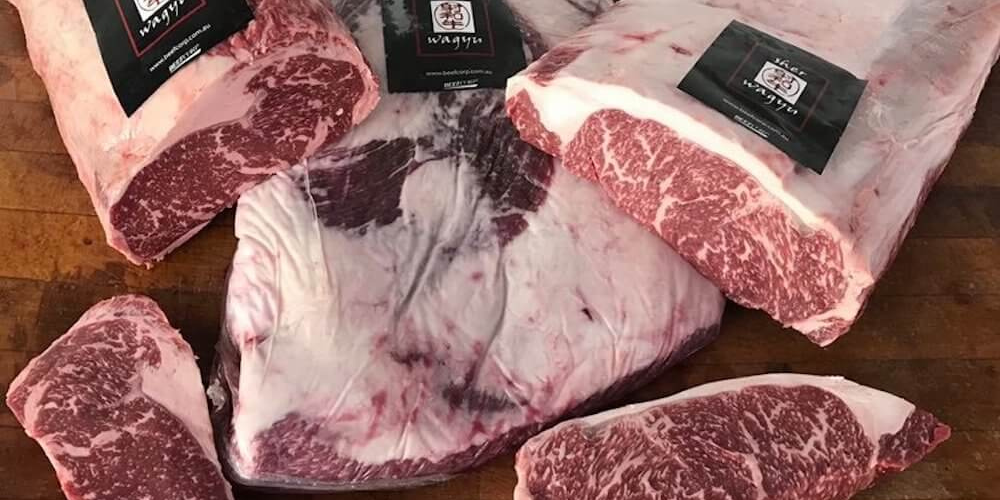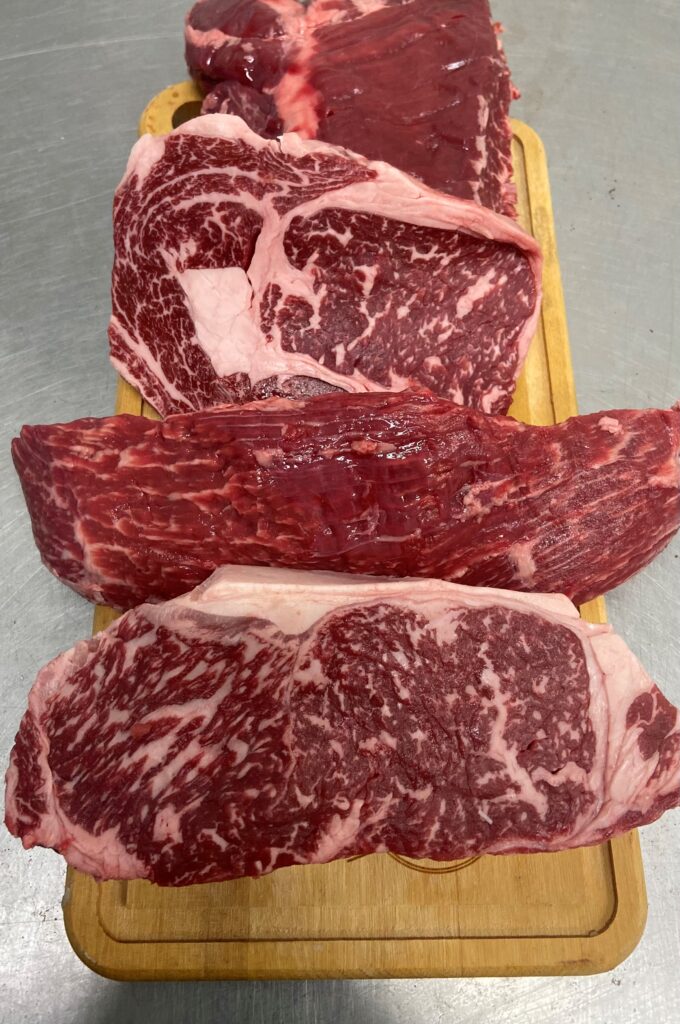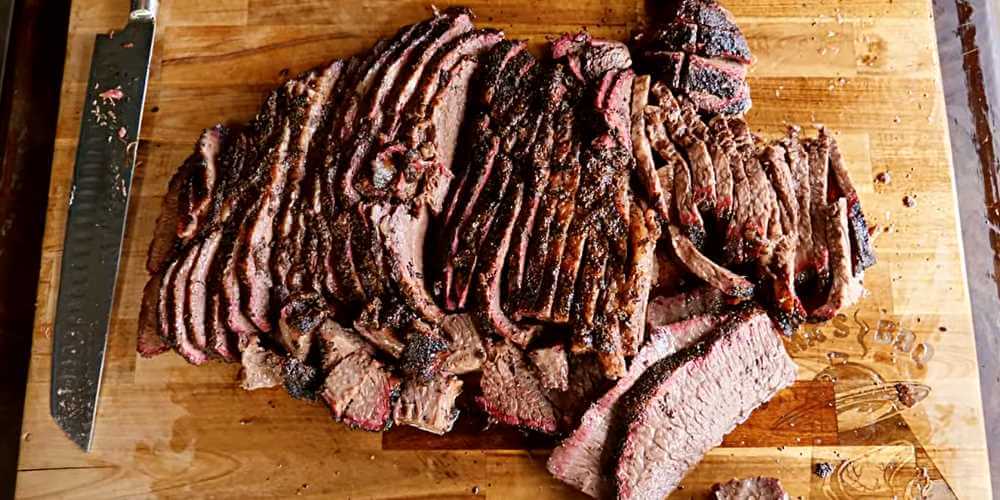Your Guide to Beef Cuts and How to Cook Them

You may feel intimidated by the grocery store’s meat counter. Why do certain meats cost more than others? Why are porterhouse steaks generally a little more expensive than T-bone steaks? Why is a particular cut of flank steak required? Despite being so close to one another physiologically, why is a chuck steak harder than a rib steak? What makes various beef slices tough or soft, and how should each be prepared? These are just some of the questions that may cross our minds when browsing the meat aisle or visiting your local butcher. There’s a reason why knowing your meat from inside and out is important. Choosing the proper cooking technique for the type of meat is crucial. Less tender meat pieces require moist heat cooking techniques to provide moisture, break down the meat’s tough connective tissues, and cook the meat gently and thoroughly. Let’s learn more about beef parts and how to cook them properly.
What are the major parts of a beef carcass?
Learning where parts of the animal and various pieces of meat come from is essential for mastering the art of butchery. To this goal, culinary arts students and food enthusiasts devote considerable effort to studying the anatomical structures of various animals. There are many distinct types of muscle in the body, and each one serves a specific purpose. The idea that muscles used more frequently by the animal are more complex than those used less frequently is one of the fundamental concepts in understanding meat. Don’t worry; we’re well-versed in all things beef-related and can gladly explain the various cuts and their ideal preparation methods.
Chuck
Traditionally, the butcher would sell square-cut beef chuck, which included the animal’s ribcage, shoulder, and neck. Most beef chuck was often processed into hamburgers or sold as stew meat, with the remaining portion being converted into roasts to around half the amount. The alternatives available to butchers and chefs today for ordering and creating beef chuck are far more varied. Additionally, many home cooks are beginning to look for these subprime cuts.
How to cook Chuck: Chuck steak tastes best whether cooked fast, such as broiling or pan-frying, or slowly, such as braising in the oven. You’ll quickly understand why chuck steak is a delectable and well-liked cut if you choose a technique that suits your skill level.
Rib
Where do beef ribs come from? After the brisket is removed, the forequarter is used to prepare the short ribs. They consist of rib flesh and fat layered over the rib bone. The ribs are made of the backbone and ribs of the cow. Only the final segment (6–12) of the 13 pairs of ribs are found in the primordial region. The chuck cut is where the others are. Ribs are highly flavorful and marbled. For ribs, common cuts include beef short ribs, boneless ribeye roast, cowboy steak, and ribeye steaks.
How to cook Ribs: Baking ribs covered at a low temperature is the best and most reliable approach to ensure they fall off the bone tender. Beef ribs are marinated or coated with a dry rub and baked for two to three hours at 275 degrees Fahrenheit. This straightforward technique ensures tender ribs! Others choose to boil, grill, or smoke their ribs, but low and slow cooking is prefered.
Loin
Some of the sharpest cuts, like the expensive tenderloin’s front end, are found in the loin primal, which starts with the 13th and last rib. Known as the short loin in traditional American butchery, this section is used to make thick steaks. Your most costly cuts of beef may be found here. Because of its position beneath the rib cage, the loin is rarely put to work. When opposed to more muscular cuts, the loin is very tender. There are two notable sub-parts of the loin primal cut: the sirloin and the short loin.
How to cook Loin: To guarantee that the beef tenderloin is thoroughly and evenly cooked without drying out, roast it slowly at a low temperature. It is finished off under the broiler for a stunning colour and even more taste. The finest way to eat beef tenderloin is medium-rare. Since this cut is so lean, cooking it past medium risked making it dry and flavourless. The secret to a flavorful and excellent beef tenderloin is a meat thermometer and lots of love!
Round
The meat from the back of a cow’s hindquarters is known as round steak (aka the Beef Round primal cut). Due to regular exercise, the muscles of the rear legs are unquestionably more slim and robust. Top Round, Bottom Round, Eye of Round, and Sirloin Tip are the four typical steak and roast cuts carved from the Beef Round.
How to cook Round: Round Steak is a soft cut of beef that benefits from being cooked with a little bit of liquid. Braising and slow cooking are examples of moist cooking. Braising involves using less liquid and frequently begins with the meat pan-seared to increase flavour. Slow cooking involves covering the meat with liquid and cooking it gently over a longer period.
Flank
The flank is the lower part of the cow’s body used to make steaks like flank steak. Because it is a vital chunk of meat with long, thick muscle fibres, it can become chewy and rough if cooked improperly. While fat often gives steak its flavour, flank steak has a distinct flavour that may be considerably improved and heightened by seasoning and marinades.
How to cook Flank: If you don’t know what you’re doing while cooking flank steak, you’re likely to have a tough steak. A fantastic flank steak may be prepared in several ways, including grilling, low and slow cooking, and sous vide. Although it might be a little challenging to work with, it can provide your selected meal with an intense and meaty flavour when cooked properly.
Short Plate
Short plate slices are located close to the cow’s stomach and are frequently associated with the brisket meat area. Because of its placement in the cow, it makes for inexpensive, rough, and fatty meat cuts. You may often buy skirt steak, hanger steak, beef bacon, pastrami, short ribs, and ground beef from this primal cut in supermarkets in small plate portions.
How to cook Short Plate: Before grilling, trim the fat cap off the meat and divide it into servings. The short plate beef cut is frequently utilised for ground beef because of its high composition. It works well for fajitas and stir-frying. Chefs frequently use small plate to prepare beef pastrami or bacon.
Brisket
While beef brisket is one of the most delectable slices of meat, it is tough and requires careful cooking to bring out its full potential. It’s a fatty cut of beef, but the fat melts away while cooking, leaving you with soft, flavorful meat. The brisket is tough and fatty, needing extensive cooking to become tender since its muscles support the cow’s weight. It may be fashioned into corned beef or pastrami, braised for Passover, and smoked for barbeque. Don’t forget to buy your brisket from a reputable low and slow butcher in your neighbourhood.
How to cook Brisket: Beef brisket may be converted into a silky, soft, and delicious dinner when cooked correctly. Brisket is best prepared using techniques like braising or smoking that call for a low temperature and prolonged cooking time. It works wonderfully in casseroles and pot roasts, but its uses go far beyond that. To learn more about the best ways to prepare your beef brisket, ask your neighbourhood butcher for some advice.
Shank
The beef shank comes from the lower leg of the cow or bull. When compared to other cuts of beef, this sort of meat is renowned for its low fat content and rough texture. Cattle’s leg muscles are weight-bearing, thus they develop into thick, stringy tissue throughout the course of the animal’s lifetime. Although it is lean, this cut is full of taste since it is made mostly of black flesh. Two shanks, one in the forequarter and one in the hindquarter, are present on each side of the beef.
How to cook Shank: Because it is so lean, shank meat is a great choice for lean ground beef. It is a component of stews, soups, and meals like beef bourguignon. Shank meat is used in traditional dishes all around the world since it is a less expensive cut of meat. It has long been a well-liked cut in Asia.

What are the most fatty cuts of beef?
The wonderful flavour and texture that distinguish fatty cuts of beef from other animal meats are there in abundance. These cuts offer a lot of tastes in addition to the delicious marbling that consumers have grown accustomed to. Remember that certain cuts may not always be the best to consume because they are more expensive and contain more saturated fat.
- Filet Mignon
- Flap Steak
- Porterhouse Steak
- Skirt Steak
- NY Strip Steak
- T-bone Steak

